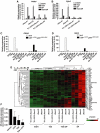Two transactivation mechanisms cooperate for the bulk of HIF-1-responsive gene expression
- PMID: 16237459
- PMCID: PMC1283945
- DOI: 10.1038/sj.emboj.7600846
Two transactivation mechanisms cooperate for the bulk of HIF-1-responsive gene expression
Abstract
The C-terminal activation domain (C-TAD) of the hypoxia-inducible transcription factors HIF-1alpha and HIF-2alpha binds the CH1 domains of the related transcriptional coactivators CREB-binding protein (CBP) and p300, an oxygen-regulated interaction thought to be highly essential for hypoxia-responsive transcription. The role of the CH1 domain in vivo is unknown, however. We created mutant mice bearing deletions in the CH1 domains (DeltaCH1) of CBP and p300 that abrogate their interactions with the C-TAD, revealing that the CH1 domains of CBP and p300 are genetically non-redundant and indispensable for C-TAD transactivation function. Surprisingly, the CH1 domain was only required for an average of approximately 35-50% of global HIF-1-responsive gene expression, whereas another HIF transactivation mechanism that is sensitive to the histone deacetylase inhibitor trichostatin A (TSA(S)) accounts for approximately 70%. Both pathways are required for greater than 90% of the response for some target genes. Our findings suggest that a novel functional interaction between the protein acetylases CBP and p300, and deacetylases, is essential for nearly all HIF-responsive transcription.
Figures






Similar articles
-
Complex regulation of the transactivation function of hypoxia-inducible factor-1 alpha by direct interaction with two distinct domains of the CREB-binding protein/p300.J Biol Chem. 2010 Jan 22;285(4):2601-9. doi: 10.1074/jbc.M109.021824. Epub 2009 Oct 30. J Biol Chem. 2010. PMID: 19880525 Free PMC article.
-
The acetylase/deacetylase couple CREB-binding protein/Sirtuin 1 controls hypoxia-inducible factor 2 signaling.J Biol Chem. 2012 Aug 31;287(36):30800-11. doi: 10.1074/jbc.M111.244780. Epub 2012 Jul 17. J Biol Chem. 2012. PMID: 22807441 Free PMC article.
-
Functional analysis of hypoxia-inducible factor-1 alpha-mediated transactivation. Identification of amino acid residues critical for transcriptional activation and/or interaction with CREB-binding protein.J Biol Chem. 2002 Oct 11;277(41):38723-30. doi: 10.1074/jbc.M205051200. Epub 2002 Jul 19. J Biol Chem. 2002. PMID: 12133832
-
HIF-1 and HIF-2 transcription factors--similar but not identical.Mol Cells. 2010 May;29(5):435-42. doi: 10.1007/s10059-010-0067-2. Epub 2010 Apr 12. Mol Cells. 2010. PMID: 20396958 Review.
-
Role of Intrinsic Protein Disorder in the Function and Interactions of the Transcriptional Coactivators CREB-binding Protein (CBP) and p300.J Biol Chem. 2016 Mar 25;291(13):6714-22. doi: 10.1074/jbc.R115.692020. Epub 2016 Feb 5. J Biol Chem. 2016. PMID: 26851278 Free PMC article. Review.
Cited by
-
Genome-wide analysis of HIF-2α chromatin binding sites under normoxia in human bronchial epithelial cells (BEAS-2B) suggests its diverse functions.Sci Rep. 2016 Jul 4;6:29311. doi: 10.1038/srep29311. Sci Rep. 2016. PMID: 27373565 Free PMC article.
-
Endoplasmic reticulum stress, genome damage, and cancer.Front Oncol. 2015 Feb 3;5:11. doi: 10.3389/fonc.2015.00011. eCollection 2015. Front Oncol. 2015. PMID: 25692096 Free PMC article. Review.
-
A membrane protease regulates energy production in macrophages by activating hypoxia-inducible factor-1 via a non-proteolytic mechanism.J Biol Chem. 2010 Sep 24;285(39):29951-64. doi: 10.1074/jbc.M110.132704. Epub 2010 Jul 27. J Biol Chem. 2010. PMID: 20663879 Free PMC article.
-
Hypoxia-Inducible Factor (HIF)-1 regulatory pathway and its potential for therapeutic intervention in malignancy and ischemia.Yale J Biol Med. 2007 Jun;80(2):51-60. Yale J Biol Med. 2007. PMID: 18160990 Free PMC article. Review.
-
Genetic interaction between mutations in c-Myb and the KIX domains of CBP and p300 affects multiple blood cell lineages and influences both gene activation and repression.PLoS One. 2013 Dec 10;8(12):e82684. doi: 10.1371/journal.pone.0082684. eCollection 2013. PLoS One. 2013. PMID: 24340053 Free PMC article.
References
-
- Alarcon JM, Malleret G, Touzani K, Vronskaya S, Ishii S, Kandel ER, Barco A (2004) Chromatin acetylation, memory, and LTP are impaired in CBP(+/−) mice; a model for the cognitive deficit in Rubinstein–Taybi syndrome and its amelioration. Neuron 42: 947–959 - PubMed
-
- Brugarolas JB, Vazquez F, Reddy A, Sellers WR, Kaelin WG Jr (2003) TSC2 regulates VEGF through mTOR-dependent and -independent pathways. Cancer Cell 4: 147–158 - PubMed
-
- Bruick RK (2003) Oxygen sensing in the hypoxic response pathway: regulation of the hypoxia-inducible transcription factor. Genes Dev 17: 2614–2623 - PubMed
-
- Compernolle V, Brusselmans K, Acker T, Hoet P, Tjwa M, Beck H, Plaisance S, Dor Y, Keshet E, Lupu F, Nemery B, Dewerchin M, Van Veldhoven P, Plate K, Moons L, Collen D, Carmeliet P (2002) Loss of HIF-2alpha and inhibition of VEGF impair fetal lung maturation, whereas treatment with VEGF prevents fatal respiratory distress in premature mice. Nat Med 8: 702–710 - PubMed
Publication types
MeSH terms
Substances
Grants and funding
LinkOut - more resources
Full Text Sources
Other Literature Sources
Molecular Biology Databases
Research Materials
Miscellaneous

